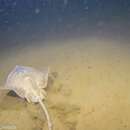Lifespan, longevity, and ageing
provided by AnAge articles
Maximum longevity: 14 years (wild)
- license
- cc-by-3.0
- copyright
- Joao Pedro de Magalhaes
- editor
- de Magalhaes, J. P.
Diagnostic Description
provided by Fishbase
Spines are larger toward front and disappear with age on rear parts of tail. Few scapular spines. Group of spines in front of and around each eye. Adults have 1 middorsal row of many small spines, 1 row of small spines on each side, middorsal row of spines extend forward on disk to area behind eyes. Young have 2 pale crossbars on tail, each outlined by a dark blotch or band. Snout pointed (Ref. 7251). Upper surface pale brown with numerous obscure darker spots, irregular pale markings. Lower surface plain white with few small dusky spots (Ref. 6902).
- Recorder
- Arlene G. Sampang-Reyes
Life Cycle
provided by Fishbase
Oviparous, paired eggs are laid. Embryos feed solely on yolk (Ref. 50449). Distinct pairing with embrace. Young may tend to follow large objects, such as their mother (Ref. 205).
Migration
provided by Fishbase
Oceanodromous. Migrating within oceans typically between spawning and different feeding areas, as tunas do. Migrations should be cyclical and predictable and cover more than 100 km.
Trophic Strategy
provided by Fishbase
Inhabits soft mud and clay bottoms of the deeper troughs and basins, sands, sands and shells, gravel and pebbles of the offshore fishing banks (Ref. 6902). Salinity ranges from 32.6 to 35.4 (Ref. 6902). This species is confined to deep water. No occurrence has been found in less than 8 m of water (Ref. 6902). Feeds on decapod crustaceans and euphausiids, with mysids being more important. Parasites of the species include blood parasite, Haemogregarina delagei (protozoan) and Zyxibothrium kamienae (cestode) (Ref. 5951).
- Recorder
- Grace Tolentino Pablico
Biology
provided by Fishbase
Inhabits soft mud and clay bottoms of the deeper troughs and basins, sands and shells, gravel and pebbles of the offshore fishing banks (Ref. 6902). Benthic (Ref. 5951). Salinity ranges from 32.6 to 35.4 (Ref. 6902). This species is confined to deep water. No occurrence has been found in less than 8 m of water. Oviparous. Distinct pairing with embrace. Young may tend to follow large objects, such as their mother (Ref. 205). Eggs are oblong capsules with stiff pointed horns at the corners deposited in sandy or muddy flats (Ref. 205). Egg capsules are 5.0-5.9 cm long and 3.8-4.5 cm wide (Ref. 41249, 41306, 41301). Caught too sparingly to have any commercial importance (Ref. 27314).
Importance
provided by Fishbase
fisheries: of no interest
Distribution
provided by World Register of Marine Species
Newfoundland Banks and southern Gulf of St. Lawrence to New Jersey
North-West Atlantic Ocean species (NWARMS)
- license
- cc-by-4.0
- copyright
- WoRMS Editorial Board
Habitat
provided by World Register of Marine Species
Found on both mud and clay bottoms; confined to deep waters.
North-West Atlantic Ocean species (NWARMS)
- license
- cc-by-4.0
- copyright
- WoRMS Editorial Board
Habitat
provided by World Register of Marine Species
benthic
North-West Atlantic Ocean species (NWARMS)
- license
- cc-by-4.0
- copyright
- WoRMS Editorial Board

